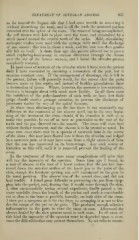Page 941 - My FlipBook
P. 941
TREATMENT OF ALVEOLAR ABSCESS. 951
SO far toward the lingual side that I had some trouble in removing it
without disturl:>ing the teeth, and in all the teeth the necrosed portion
extended over the apices of the roots. The removal being accomplished,
the soft tissues were laid in place over the roots, and maintained by a
stitch passed around the central tooth of the series. Mild, stimulating
antiseptic washes were used with the syringe daily until the discharge
of pus ceased : this was in about a week, and the case was then gradu-
ally left to itself. A short time ago this patient allowed me to pass a
small exploring-instrument in various directions through the tissues
over the site of the former necrosis, and I found the alveolar process
completely restored.
In most cases of necrosis of the alveolus where I have seen the patient
daily I have succeeded in obtaining a restoration of the part, but it
requires constant care. If the management of dressings, etc. is left to
the patient, failure will generally result, for the reason that the parts
become more or less septic, and instead of healthy granulations there
is destruction of tissue. Where, however, the necrosis is less extensive,
recovery is brought about with much more facility. In all these cases
the condition of the pulp-chambers of such teeth as have lost their
pulps should receive prompt attention, to prevent the discharge of
poisonous matter by way of the apical foramen.
In those cases discharging on the face there is not necessarily any
difference in the treatment of the abscess itself, but in the very begin-
ning of the treatment the sinus should, if its situation is such as to
make this possible, be cut off as near as practicable to the root of the
tooth and the pus directed into the mouth. The sinus will then heal
without further treatment, and the abscess is to be treated as usual. In
some rare cases there may be a spicula of necrosed bone in the course
of the sinus ; this may have floated into it from the alveolus and lodged
in a narrower part, or it may have come from a slight necrosis of bone
that the pus has uncovered in its burrowings. Any such source of
irritation as this will, until it is removed, prevent the healing of the
sinus.
In the treatment of these cases many complications will arise that
will tax the ingenuity of the operator. Some time ago I found, in
a case of abscess at the root of a lower incisor, that the pus had bur-
rowed down the anterior surface of the lower jaw to the point of the
chin, though the fistulous opening was still maintained on the gum in
the usual position. The abscess was of the second class, and did not
heal readily. I found great difficulty in preventing the pus from drop-
ping into the pocket, and, fearing that it would come through the skin,
I, after unsuccessfully trying several expedients, finally passed a bis-
toury carefully down the length of the pocket and made a considerable
cut as close to the bone as possible, laterally, on both sides of the sinus.
I then put a compress on it for two days, so arranging it as not to hin-
der the escape of the pus on the gum. This produced enough adhesive
inflammation in the parts to close the sinus at once. Afterward the
abscess healed by the slow process usual in such cases. In all cases of
this kind the ingenuity of the operator must be depended upon to over-
come the difficulties that may present themselves. No set rules to accom-


